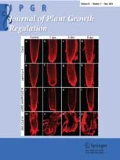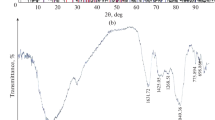Abstract
Panchagavya (PG) is an organic formulation prepared from the different byproducts of cow which has been extensively utilized as an alternative, cheaper, and effective source of organic manure in India. Its application resulted in the improvement of various factors including soil alkalinity, sodicity, acidity, fertility, nutrients, plant growth, metabolites, defense response, and yield. Salinity is a global threat to crop productivity as it turns agronomically important land into infertile area. To contemplate the complications of salinity, the current study was carried out to characterize the useful components of PG. The molecular, biochemical, and cell biological studies with PG elucidated the effective role of PG to cope up with saline stress. The expression of genes encoding catalase (CAT1), superoxide dismutase (SOD), glutathione peroxidase (GPX), transcription factor WRKY53, and Bax inhibitor 1 (BI1) were altered with PG under saline stress, indicating the PG is acting at the biochemical and molecular level. By this study, for the first time we have demonstrated the characterization of PG by Fourier Transform Infrared (FTIR) and High-Performance Liquid Chromatography (HPLC). The molecular mechanism of action of PG under saline condition is also demonstrated for the first time.






Similar content being viewed by others
References
Aebi H (1984) Catalase in vitro. Methods Enzymol 105:121–126
Athavale A, Jirankalgikar N, Nariya P, De S (2012) Evaluation of in vitro antioxidant activity of Panchagavya: a traditional ayurvedic preparation. IJPSR 3:2543–2549
Beauchamp CO, Fridovich I (1971) Superoxide dismutase: improved assays and an assay applicable to acrylamide gels. Anal Biochem 44:276–287
Bethke PC, Jones RL (2001) Cell death of barley aleurone protoplasts is mediated by reactive oxygen species. Plant J 25:19–29
Cheng CC, Yang MH, Wen HM, Chern JC (2002) Estimation of total flavonoid content in propolis by two complementary colorimetric methods. J Food Drug Anal 10:178–182
Du YY, Wang PC, Chen J, Song CP (2008) Comprehensive functional analysis of the catalase gene family in Arabidopsis thaliana. J Integr Plant Biol 50:1318–1326
Eulgem T, Somssich IE (2007) Networks of WRKY transcription factors in defense signaling. Curr Opin Plant Biol 10:366–371
FAO: Food and Agriculture Organisation of the United States (2015) Status of the world soil resources. Main report, pp 126–127
Flowers TJ, Yeo AR (1981) Variability in the resistance of Sodium chloride salinity within rice (Oryza sativa L.) varieties. New Phytol 88:363–373
Gechev TS, Gadjev IZ, Hille J (2004) An extensive microarray analysis of AAL-toxin-induced cell death in Arabidopsis thaliana brings new insights into the complexity of programmed cell death in plants. Cell Mol Life Sci 61:1185–1197
Hasegawa PM, Bressan RA, Zhu JK, Bhonert HJ (2000) Plant cellular and molecular responses to high salinity. Annu Rev Plant Physiol 51:463–499
Idrees M, Naeem M, Aftab T, Khan MMA (2011) Salicylic acid mitigates salinity stress by improving antioxidant defence system and enhances vincristine and vinblastine alkaloids production in periwinkle Catharanthus roseus (L.) G. Don. Acta Phys Plant 33:987–999
Kono Y (1978) Generation of superoxide radical during autooxidation of hydroxylamine and an assay for superoxide dismutase. Arch Biochem Biophys 186:189–195
Kumar KB, Khan PA (1982) Peroxidase in excised ragi (Eleusine coracana cv. PR 202) leaves during senescence. Indian J Exp Bot 20:412–416
Laxmi A, Laju K, Paul E, Raychaudhuri A, Janny L, Peters, Khurana JP (2006) Arabidopsis cytokinin- resistant mutant, cnr1, displays altered auxin responses and sugar sensitivity. Plant Mol Biol 62:409–425
Li L, Zhang H, Zhang L, Zhou Y, Yang R, Ding C, Wang X (2014) The physiological response of Artemisia annua L. to salt stress and salicylic acid treatment. Physiol Mol Biol Plants 20:161–169
Lin JF, Wu SH (2004) Molecular events in senescing Arabidopsis leaves. Plant J 39:612–628
Livak JK, Schmittgen TD (2001) Analysis of relative gene expression data using real-time quantitative PCR and the 2−∆∆CT method. Methods 25:402–408
Lowry OH, Rosebrough NJ, Farr AL, Randall RJ (1951) Protein measurement with the Folin phenol reagent. J Biol Chem 193:265–275
Mackinney G (1941) Absorption of light by chlorophyll solutions. J Biol Chem 140:315–322
Maclachlan S, Zalik S (1963) Plastid structure, chlorophyll concentration, and free amino acid composition of a chlorophyll mutant of barley. Can J Bot 41:1053–1062
Milla MAR, MaurerA, Rodriguez HA, Gustafson JP (2003) Glutathione peroxidase genes in Arabidopsis reubiquitous and regulated by abiotic stresses through diverse signaling pathways. Plant J 36:602–615. doi:10.1046/j.1365-313X.2003.01901.x
Mishra P, Bhoomika K, Dubey RS (2013) Differential responses of antioxidative defense system to prolonged salinity stress in salt-tolerant and salt-sensitive Indica rice (Oryza sativa L.) seedlings. Protoplasma 250:3–19
Molyneux P (2004) The use of the stable free radical diphenylpicryl-hydrazyl (DPPH) for estimating antioxidant activity. Songklanakarin J Sci Technol 26:212
Murphy LR, Kinsey ST, Durako MJ (2003) Physiological effects of short term salinity changes on Ruppiamaritima. Aquat Bot 75:293–309
Nariya P, Jirankalgikar N, Warma R, De S (2012) Analytical study & HPTLC profile of Panchagavya-A traditional ayurvedic preparation. Asian J Biochem Pharm Res 2:198–208
Pandey SP, Somssich IE (2009) The role of WRKY transcription factors in plant immunity. Plant Physiol 150:1648–1655
Patel BB, Bharat P (2011) B., Dave RS Studies on infiltration of saline–alkali soils of several parts of Mehsana and Patan districts of north Gujarat. J Appl Technol Environ Sanitation 1:87–92
Pennell RI, Lamb C (1997) Programmed cell death in plants. Plant Cell 9:1157–1168
Rahman SHA, Mostafa MAM, Taha TA, Elsharawy MAO, Eid MA (2012) Effect of different amendments on soil chemical characteristics, grain yield and elemental content of wheat plants grown on salt-affected soil irrigated with low quality water. Annals Agric Sci 57:175–182
Rajesh M, Jayakumar K (2013) Changes in morphological, biochemical and yield parameters of Abelmoschus esculents (L.) Moench due to panchagavya spray. Int J Mod Plant Anim Sci 1:82–95
Rao SP, Mishra B, Gupta SR, Rathore A (2008) Reproductive stage tolerance to salinity and alkalinity stresses in rice genotypes. Plant Breed 27:256–261
Samarajeewa PK, Barrero RA, Umeda-Hara C, Kawai M, Uchimiya H (1999) Cortical cell death, cell proliferation, macromolecular movements and rTip1 expression pattern in roots of rice (Oryza sativa L.) under NaCl stress. Planta 207:354–361
Sanchez M, Revilla G, Zara I (1995) Changes in peroxidase activity associated with cell walls during pine hypocotyl growth. Ann Bot 7:415–419
Sarkar S, Kundu SS, Ghorai D (2014) Validation of ancient liquid organics- Panchagavaya and Kunapajala as plant growth promoters. Indian J Tradit Know 2:398–403
Waterhouse AL (2003) Determination of total phenolics. In: Wrolstad RE (ed) Current protocols in food analytical chemistry, units I. Wiley, New York, pp I1.1.1–I1.1.8
Xu Q, Reed JC (1998) Bax inhibitor-1 a mammalian apoptosis suppressor identified by functional screening in yeast. Mol Cell 1:337–346
Acknowledgements
We are thankful to B.S. Abdur Rahman University, Chennai, for providing the research facility and fellowship (JRF) to M.S. Khan for carrying out the research.
Author information
Authors and Affiliations
Corresponding author
Ethics declarations
Conflict of interest
The authors declare that they have no conflict of interest.
Rights and permissions
About this article
Cite this article
Khan, M.S., Akther, T. & Hemalatha, S. Impact of Panchagavya on Oryza sativa L. Grown Under Saline Stress. J Plant Growth Regul 36, 702–713 (2017). https://doi.org/10.1007/s00344-017-9674-x
Received:
Accepted:
Published:
Issue Date:
DOI: https://doi.org/10.1007/s00344-017-9674-x




